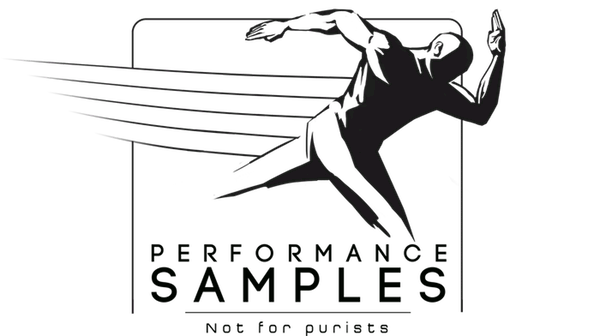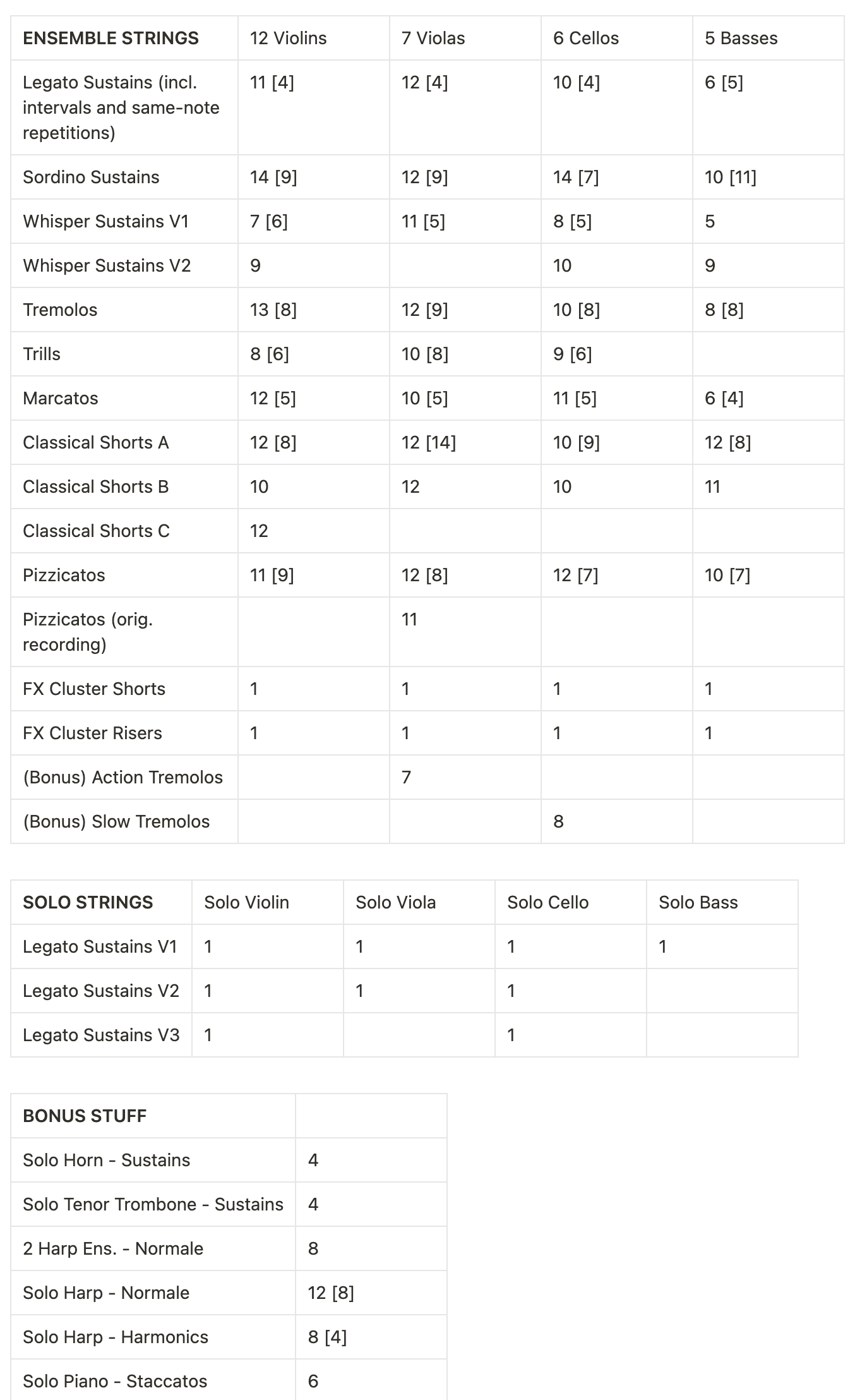FAQs
What is the difference between the original Vista and Vista II? What about Pacific Ensemble Strings?
Aside from the room and some of the musicians, there’s not lot of similarity between the original Vista and Vista II. Vista II expands far beyond the original Vista in terms of application and scope, and more than three years between recording sessions means a whole lot of evolution in development. Three years in “sampling years” is a long time.
The original Vista was chamber-sized (5-4-3-3), legato-only and heavy vibrato — rather narrow in applicability. Sometime later, Pacific Ensemble Strings came out, symphonic-sized (16-12-10-8).
In a way, Vista II vs Pacific Ensemble Strings is a more apt comparison than Vista II vs the original Vista (room aside). Pacific Ensemble Strings is symphonic-sized and recorded in a very ambient large hall with a lot of dynamics, except on legatos which have a fairly normal amount (maybe a bit more than usual). The legatos tend to have some players doing slides/position changes on the higher dynamics for larger intervals in particular.
How does Vista II compare to Pacific Ensemble Strings? First of all, Vista II is in the original Vista room, so it’s rather dry (still a bit of ambience, but comparably not much). The mic setup is also more evolved. It’s a decca setup with Neumann M150s, rather than a omni AB setup for the far mics. And there are five mic positions: close, section, decca, outrigger, and far/surround. There’s a clearer imaging with the space. Of course, it’s more of a mid-sized ensemble too: 12 violins, 7 violas, 6 cellos, and 5 basses.
Now, the dynamics are really where Vista II begins to diverge from Pacific Ensemble Strings (and really any previous PS library). The legatos have up to 12 dynamics (on the intervals as well, not just the sustains), versus the four in Pacific (though the Pacific basses had five) and the original Vista. Up to 14 dynamics on the other articulations. Generally more dynamics on Vista II’s articulations than Pacific Ensemble Strings’ — but not in every case. The articulations are fairly closely matched but there are some additional things in Vista II (minus, at least at the point of writing this, the chamber vln overlay). And then there is bonus content like solo string overlays, solo harp (also in Pacific), two harps, and some solo brass.
The legato approach is also wholly new, and not strictly bow-change nor slurring. More information about that is on the left side of the window under “Details.” It’s probably the most usable legato style I’ve built commercially so far, and is based on R&D I was doing years ago that I began revisiting sometime ago. The legatos may feel generally less homogenous/flat (in the bowing) to play as opposed to the original Vista and Pacific Ensemble Strings, perhaps more granular/fragmented/moving. Not everyone will like it. Some may find it a bit too “active.” However for those those who’ve been wanting this kind of thing, it may align well with their sensibilities.
Pacific Ensemble Strings is part of Pacific Orchestra (brass, solo strings, percussion, woodwinds, ensemble strings). I’d say Pacific Ensemble Strings has a bit of a bias towards commercial appeal versus private development sentimentality. Vista II is more of an intentional harkening back to private development in many ways (and I’m really trying and hoping to keep it on this path), although at the same time it’s addressing some of the complaints about Pacific Ensemble Strings (position changes/sliding with the legato) and the original Vista (heavy vibrato). While at the same time incorporating more active movement and expression through bowing, experimental shorts sampling techniques, exploring “chaos layers” of “crescendo fff” dynamics (super high dynamics at the very end of the dynamic range intended for more specific usage that may sound somewhat odd out of context), somewhat lighter noise reduction than Pacific Ensemble Strings’ heavier noise reduction protocol, various iterations/versions/redos of patches (like the forthcoming Voyage project). In fact, being in the same room as Voyage, rather experimental in concepts, inclusive of various iterations/versions of patches and so forth, Vista II almost feels like it could be considered an unofficial “Voyage Symphonic Strings.”
Why are there so many dynamics in this library?
The short answer is I got carried away. The longer answer is that it’s something I’m exploring right now with sampling, at least with strings (and choir, on Marshland Lite anyway). It has more benefits than I could have known before actually exploring it. Without actually putting it into practice over multiple projects and instruments, heavier dynamic sampling is something that is perhaps rather easy to dismiss as a developer. But it is certainly far from the whole picture/solution to a good library. I think one aspect from a user perspective that may be beneficial is being able to sit in certain dynamic areas without infringing on abrasive dynamic areas (from fewer dynamics being recorded and the layer crossfading in). A big ‘downside’ is the recording time, and that one stung with Vista II but ultimately will be worth the experience and education I think. Ultimately it’s something I’m exploring right now but the benefit is generally something I’m leaving up to users to evaluate for themselves based on listening and playing demo patches when applicable. Here’s a session example from Vista II of the gradient near the top of the dynamic range as the players move into truly “crescendo FFF” territory, to get an idea of how far some things go in Vista II.
Are there same-note repetitions / same-note legato?
Absolutely, in the style of Pacific Ensemble Strings, but with a lot more dynamics, more mic control, and a drier, more present room.
What style of legato is in this library?
Please see the “Details” on the right of the page – there’s some information about the legato/bowing in the library.
Why is a piano, harp, and other rather unrelated content included?
It’s mostly to give people some more timbres to write/experiment with and get a sense of the depth of the room / different instruments in tutti in the space. This is actually the same room as Voyage was recorded in (granted, I still want to record more for that project), so in a way it gives an idea of how that full orchestra type sound will be in this space (although Voyage is a smaller string ensemble). Ultimately though, it’s mostly just for fun. The solo strings are the most “functional” bonus, in that they are meant to double the ensembles for extra glue, definition, etc.. but can be used as solos as well although not all the recording versions are equal — I did several passes of legatos (different days/sessions) and so you have access to different “passes” of legato — some worked better than others. All are included.
There were also cases where I recorded something but wasn’t too happy with it for whatever reason so decided to re-record it. Viola pizzicatos was one of those occasions. I didn’t think it got loud enough but didn’t want to just grab the top dynamic because of continuity concerns so I re-recorded it all. Ultimately I’m not sure if the original recording was as lacking as I originally thought, but regardless, both versions are in the library. Same thing with the whisper sustains. I know that sometimes just because I find that something can be lacking doesn’t mean it should just be thrown away, and can still find use as a bonus — so that’s part of the reasoning behind including various versions and attempts in the library (much like in the forthcoming Voyage library).
Are there multiple arco shorts?
There were multiple arco shorts recorded. I did these a little bit differently than how I’ve traditionally done rep sampling in the past. I’m starting to find traditional repetition sampling rather boring, at least for string shorts. It does depend on the players and room, but it can just default to something rather mechanical. I did come up with something I call classical (or motion) shorts on the Voyage sessions back in 2020 (old example here). It’s a tricky concept but I’ve been playing more with it and I did it for the soloists on Fluid Shorts 3, as an example. In this case they were instructed to play staccatissimo. The shorts in this lib are still very work-in-progress and may have some additional recordings as well, so I do plan to have some more demonstrations and so forth coming up.
Multiple mic positions?
There are more mics than usual on this library, and this is what I plan to head towards more. In this case: close, section, decca (Neumann 150s), outrigger, and far/surround.

